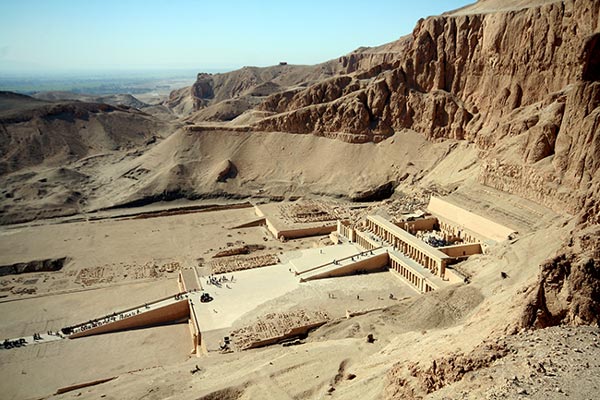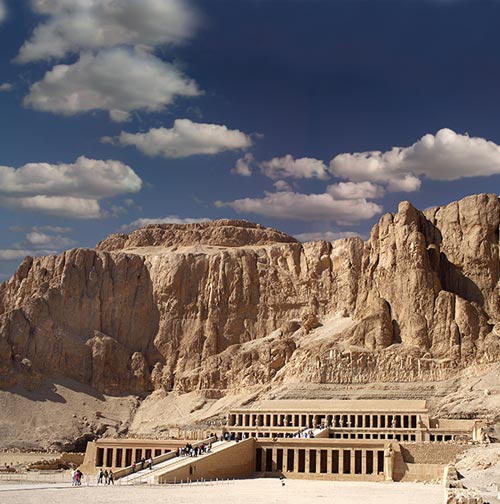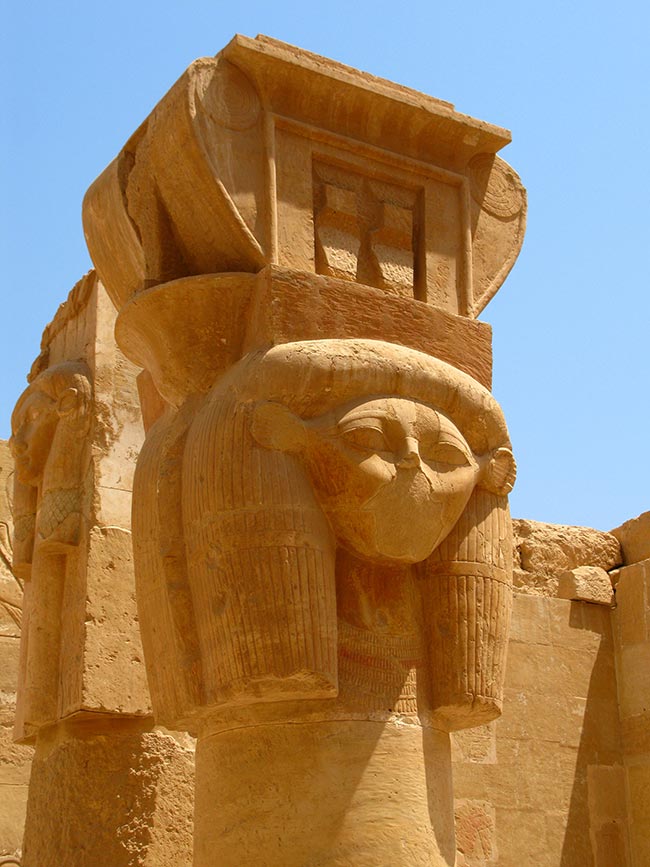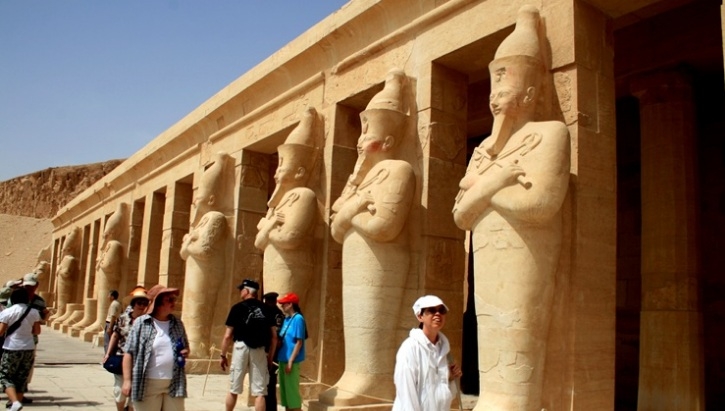Mortuary Temple of Hatshepsut | Hatshepsut Temple Luxor Egypt
Perched majestically against the cliffs of Deir el-Bahari, overlooking the western bank of the Nile in Luxor, the Mortuary Temple of Hatshepsut stands as one of ancient Egypt’s most iconic and elegant architectural achievements. Known for its harmonious terraces, monumental colonnades, and exquisite reliefs, this temple is not only a testament to the reign of Queen Hatshepsut, one of Egypt’s most remarkable pharaohs, but also an enduring symbol of the artistry and religious devotion of the New Kingdom.
Visiting Hatshepsut’s temple is like stepping into a story carved in stone — a narrative of divine birth, political power, sacred rituals, and remarkable engineering. From the moment you approach the first terrace, you are immersed in the grandeur of ancient Egypt, where architecture, religion, and landscape converge into an awe-inspiring experience.
Historical Background: Queen Hatshepsut and Her Legacy
Hatshepsut ruled Egypt during the 18th Dynasty (around 1479–1458 BCE), a period known for prosperity, territorial expansion, and monumental architecture. Unlike many rulers of her time, Hatshepsut was a female pharaoh, adopting the full titulary and regalia of kingship. Her reign brought stability, economic growth, and artistic innovation, leaving an indelible mark on Egyptian history.
The Mortuary Temple of Hatshepsut was commissioned to honor both her reign and her deified status after death. Designed by her chief architect, Senenmut, the temple was carefully integrated into the natural cliffs, creating a visual dialogue between man-made structures and the grandeur of nature.
Unlike other mortuary temples, which often stood isolated in flat landscapes, Hatshepsut’s temple rises in three elegantly stacked terraces connected by ramps, symbolizing a journey from the earthly realm toward the divine.

Architecture and Design
The temple’s architecture is celebrated for its perfect symmetry, clean lines, and monumental terraces. Constructed primarily of limestone, the temple stretches approximately 140 meters along the base of the cliffs.
Three Terraces
-
Lower Terrace – Visitors begin here with a wide open courtyard, flanked by colonnades. This terrace contains shrines dedicated to Hathor, the goddess of love and music, emphasizing the queen’s divine legitimacy.
-
Middle Terrace – Accessible by a long central ramp, this level houses the famous chapel of Anubis, as well as shrines depicting Hatshepsut’s trading expeditions to Punt. Reliefs on this terrace illustrate the arrival of exotic goods such as incense, myrrh, ebony, and gold — evidence of Egypt’s thriving international trade.
-
Upper Terrace – The final terrace contains the main sanctuary dedicated to Amun-Ra, the chief deity of Thebes. Here, Hatshepsut’s divine birth is depicted in intricate reliefs, portraying her as the daughter of Amun himself — a powerful statement of her divine right to rule.
Colonnades and Ramps
The temple is supported by long colonnades on each terrace, creating a rhythm of light and shadow as the sun moves across the façade. The ramps connecting the terraces were designed not just for functionality but as ceremonial paths, allowing priests and offerings to ascend gracefully toward the sanctuary.
Reliefs and Artistry
The temple’s reliefs are among the most exquisite examples of New Kingdom art. They tell the story of Hatshepsut’s life, divine birth, reign, and her diplomatic achievements.
Divine Birth
One of the most famous reliefs depicts Hatshepsut’s divine conception by Amun. According to the inscriptions, Amun impregnated Queen Ahmose, Hatshepsut’s mother, ensuring that the pharaoh was of divine origin. This artistic narrative reinforced Hatshepsut’s authority and legitimacy in a male-dominated society.
Expedition to Punt
The temple also commemorates Hatshepsut’s expedition to Punt, an ancient trading partner of Egypt. Reliefs show the queen receiving exotic goods, exotic animals, and detailed depictions of Puntite ships. These scenes are a testament to Egypt’s wealth and Hatshepsut’s diplomatic and economic acumen.
Religious Rituals
Throughout the temple, reliefs depict Hatshepsut offering gifts to gods, performing rituals, and receiving divine approval. The detailed hieroglyphs, carved with precision, offer insights into religious practices, ceremonial clothing, and royal iconography of the New Kingdom.
.jpg)
Integration with the Landscape
Hatshepsut’s temple is unique in its seamless integration with the surrounding cliffs of Deir el-Bahari. The design creates a visual harmony between man-made structures and nature. From the terraces, visitors enjoy breathtaking views of the Nile valley and surrounding desert, providing a serene and almost spiritual experience.
The cliffs themselves served as natural fortification and dramatic backdrop, amplifying the temple’s grandeur. This careful attention to the natural environment demonstrates the advanced architectural sensibilities of ancient Egypt.
Funerary and Religious Significance
The Mortuary Temple of Hatshepsut was not only a place to honor the queen’s reign but also served funerary and ritual purposes. Priests conducted daily offerings to Amun-Ra, ensuring Hatshepsut’s eternal life and maintaining divine favor.
Unlike tombs hidden in the Valley of the Kings, mortuary temples were highly visible monuments meant to celebrate the pharaoh’s legacy and sustain their memory in the religious life of the community. Hatshepsut’s temple exemplifies this dual purpose: a combination of commemorative grandeur and sacred function.
Discovery and Restoration
Though partially destroyed over the centuries, the temple has been carefully restored by Egyptologists since the early 20th century. Much of the damage was due to Thutmose III, Hatshepsut’s stepson, who sought to erase traces of her reign. Many of her statues were defaced, and her name was chiselled out in places.
Modern restorers have painstakingly reconstructed the terraces, repaired damaged reliefs, and preserved the remaining statues, allowing visitors to appreciate the temple’s original magnificence. Today, it stands as one of the most beautifully preserved monuments of the New Kingdom.

Visiting the Mortuary Temple of Hatshepsut
???? Location
Deir el-Bahari, West Bank of Luxor, Egypt
???? Opening Hours
Daily: 6:00 AM – 5:00 PM
???? Entrance Fee (2025)
General Admission: 140 EGP
Student Ticket: 70 EGP
???? Getting There
The temple is accessible from Luxor via taxi, private car, or guided tour. It is located near other attractions, including the Valley of the Kings and the Colossi of Memnon.
???? Travel Tips
-
Visit early morning to avoid crowds and heat.
-
Hire a licensed guide to understand the rich history of each terrace and relief.
-
Wear comfortable shoes for walking on uneven stone surfaces.
-
Bring water, sunscreen, and a hat.
Nearby Attractions
-
Valley of the Kings: Explore the tombs of Egypt’s most famous pharaohs.
-
Temple of Mentuhotep: Another mortuary temple at Deir el-Bahari.
-
Colossi of Memnon: Two enormous statues that once guarded a mortuary temple.
-
Luxor Temple: Connected to Karnak Temple via the Avenue of Sphinxes.
Combining these sites makes for a full day of Theban necropolis exploration.
Cultural and Spiritual Experience
Visiting Hatshepsut’s temple is more than sightseeing; it is a journey into the spiritual and political life of ancient Egypt. The serene terraces, the monumental colonnades, and the artistic reliefs create a contemplative atmosphere.
As visitors walk through the temple, they are transported to a time when pharaohs were considered divine, and every ritual, carving, and architectural choice reflected a delicate balance between heaven, earth, and the Nile valley.
Educational Importance
The temple is a living classroom for Egyptologists, students, and travelers. The site provides insights into:
-
Ancient Egyptian architecture and construction techniques.
-
New Kingdom religious practices.
-
The political strategies of a female pharaoh.
-
Ancient Egyptian artistry and symbolism.
Workshops and guided tours allow visitors to understand how Hatshepsut’s reign shaped the political, religious, and artistic landscape of Egypt.

Photography and Visual Highlights
-
Terraces: Capture the three-tiered design with the cliff as a dramatic backdrop.
-
Reliefs: Focus on the divine birth scene and the Punt expedition.
-
Panoramic Views: From the upper terrace, view the Nile valley and desert expanses.
-
Colonnades: Photograph the alignment and shadows of the columns.
For the best lighting, mornings and late afternoons are ideal.
Legacy of Hatshepsut and Her Temple
Hatshepsut’s temple is a lasting symbol of female power in ancient Egypt. Despite attempts to erase her memory, her architectural genius and political achievements endure through this magnificent structure.
The temple’s elegance, symmetry, and detailed carvings continue to inspire historians, architects, and travelers worldwide. It represents a fusion of artistry, devotion, and diplomacy, encapsulating the grandeur of Egypt’s New Kingdom.
Conclusion
The Mortuary Temple of Hatshepsut is one of Luxor’s most spectacular landmarks, blending history, religion, and architectural mastery into a single harmonious monument. Its terraces, reliefs, and sanctuaries tell the story of a queen who defied convention, ruled with vision, and left an everlasting mark on Egypt’s cultural and spiritual heritage.
For travelers seeking both beauty and history, Hatshepsut’s temple offers an unforgettable experience — a chance to walk where ancient royalty once tread, to witness art carved in stone, and to feel the spirit of Egypt’s golden age.
Visit the Mortuary Temple of Hatshepsut — explore the terraces, uncover the stories of a legendary queen, and experience the timeless grandeur of ancient Thebes today!

